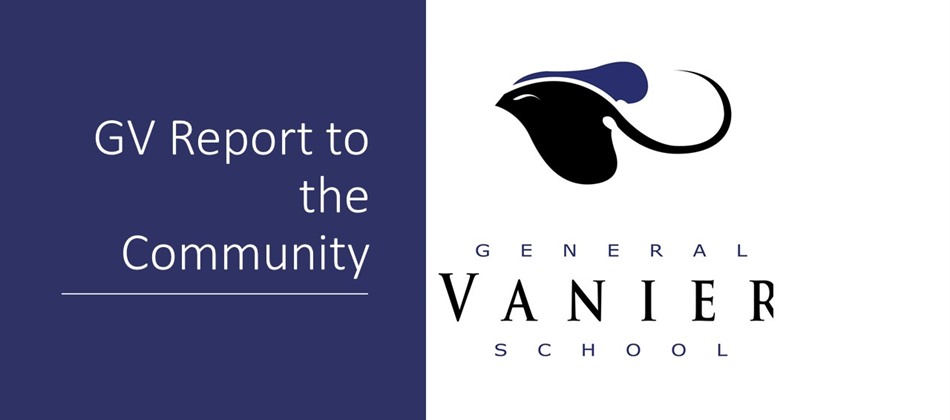General Vanier Report to the Community 2018 2019
Vision: To create an engaging learning environment focused on collaboration, inclusion, and opportunity.
As with all schools in the Louis Riel School Division, School Plans are generated each year to enhance and improve the teaching and learning conditions for our school communities. Creation of the 2018/2019 School plan began in the 2017/2018 school year and used Bruce Welman's approach to exploring school data to generate goals for the school. This process included having staff make predictions, question their assumptions and then describe school data so that themes and concerns could be generated for greater exploration in the 2018/2019 school year. Data reviewed included:
The following three topics became the foci for staff development, use of professional development days, professional conversations during staff meetings and in the creation of teacher professional learning plans.
As a result of our goal setting the following are some highlights of the initiatives and changes to our school that were developed.
1. The continued development of our K-8 literacy and numeracy plans.
2. The move from integration to inclusion-based practices throughout the school.
3. The creation of a Mental Health Promotion Plan for staff and students.
In the future, staff will continue to use available data to create plans for the school that will enhance and continue the work that has been done.
As with all schools in the Louis Riel School Division, School Plans are generated each year to enhance and improve the teaching and learning conditions for our school communities. Creation of the 2018/2019 School plan began in the 2017/2018 school year and used Bruce Welman's approach to exploring school data to generate goals for the school. This process included having staff make predictions, question their assumptions and then describe school data so that themes and concerns could be generated for greater exploration in the 2018/2019 school year. Data reviewed included:
- Pan-Canadian assessment of Reading Mathematics and Science
- Middle Years Assessment
- 2015/2016 Mental Health Survey
- Early Development Instrument 2016/2017
- OurSchool Survey
- Staff generated responses from surveys and exit slips from various PD events
The following three topics became the foci for staff development, use of professional development days, professional conversations during staff meetings and in the creation of teacher professional learning plans.
- The continued development of our K-8 literacy and numeracy plans.
- The move from integration to inclusion-based practices throughout the school.
- The creation of a Mental Health Promotion Plan for staff and students.
As a result of our goal setting the following are some highlights of the initiatives and changes to our school that were developed.
1. The continued development of our K-8 literacy and numeracy plans.
- In a multi-divisional professional development experience on Feb 1st, staff were introduced to Nottingham's ideas of "The Learning Pit" and the elements of developing challenging learning experiences for students.
- Student Services staff created a breakdown of grade level math concepts, current strategies in place, and possible resources to be explored to improve teacher pedagogy and student learning. As a result we saw improvements in students' mathematical ability.
- Staff examined computer resources to pinpoint and address students with lagging skills, and an introduction to assistive technologies to improve fluency in reading and writing was also considered and tried with a number of students.
2. The move from integration to inclusion-based practices throughout the school.
- A full-time occupational therapist was transitioned into the school to support the learning needs of our students receiving skills for living programming.
- After a successful trial in 2017/2018, alterations were made and we solidified our School Profile Planning Process and included connections to Tier 1, 2, and 3 interventions. We embedded practices to include our Clinical Services Team.
- A renovation to the skills for living programming spaces has allowed for greater opportunities for reverse integration and has allowed students and staff greater ability to program and manage programming.
- On March 15 staff reviewed resources created by Shelley Moore that would encourage and give tools for the inclusion of all students in appropriate and meaningful ways. Baselines were created to evaluate the frequency and quality of inclusionary practices.
3. The creation of a Mental Health Promotion Plan for staff and students.
- Staff and students co-created plans after learning about the Zones of Regulation.
- Staff received an introduction to Trauma Informed Research, Care and Practice from our social worked Kim Mackey on September 17th and during a Family of Schools professional development day on April 26th we continued to develop our understanding of the effects that Trauma has on individuals in a workshop by Sheri Coburn.
- A group of four staff attended Mental Health in Schools Planning Sessions put on by the Winnipeg Regional Health Authority. As a result of these meetings, school professional development days were used to create a data driven proposal for the creation of a Mental Health Strategy for GV School and the community.
- Teachers were given a formal introduction to the online record keeping system CLEVR as a way to ensure that accurate information about the wellbeing of our students is shared among school, divisional, and clinical services staff.
- Creation of a lunchroom, allowed students to eat in one space which increased staff ability to supervise students and cut down the number of reported issues from the classroom.
- The Mind-Up curriculum (designed to increase the understanding of what students know about the way they think and feel) was implemented at the 1, 2, 3 grade levels.
In the future, staff will continue to use available data to create plans for the school that will enhance and continue the work that has been done.


